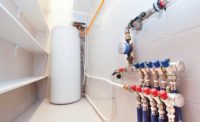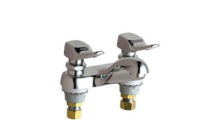While students and teachers take the summer off, facility owners and maintenance crews are busy making repairs and improvements. But the work doesn’t stop once school is back in session: It is a year-round effort to ensure educational buildings are in tip-top shape. This means much more than making buildings functional. Facility owners are interested in renovations that will help save money and increase student enrollment. Let’s explore three essential areas to focus school time and resources.
In 2014, more than $3 billion was spent on renovating K-12 schools and $1.5 billion was spent on updating existing colleges, according to the 20th Annual School and College Planning Construction Reports. Of these renovations, plumbing upgrades such as replacing flush valves, faucets and showerheads are one of the most frequently undertaken projects. This is not surprising, especially when you calculate the reduced maintenance costs and additional benefits a facility can experience simply by retrofitting fixtures.
Flush valves: It’s important to select quality products to ensure optimal functionality and all flush valves are not created equal. There are two types: diaphragm and piston technology.
Common diaphragm flush valve designs generally are repaired after three to 12 months, making this a costly choice for schools due to the additional replacement parts and labor. Instead, opt for piston technology, which virtually requires no maintenance or replacement parts for the life of the flush valve, thus increasing the bottom line due to less upkeep over time. Pistons can withstand water pressure fluctuations which is especially important in older buildings.
The technology also works better when dealing with line debris, which results from poor water supply cleanliness. Another consideration when choosing piston technology is to select a model with double O-ring seals at the handles. This will help prevent leaks at the often-abused connection (e.g., students repeatedly hitting the handle with their foot). When choosing a flush valve, products that are durable and designed to withstand the wear and tear of heavy daily usage offer the best return on investment.
Faucets: Cost savings doesn’t only come from choosing reliable products; facility managers should keep water usage and utility costs in mind, as well. With more laws requiring water conservation, facilities such as Community Consolidated School District 15 in Palatine, Ill., are placing a greater emphasis on water-efficient products.
“We’ve reduced our monthly costs by nearly 50% by replacing hundreds of faucets and flush valves,” says Craig Phillips, manager of environmental services at the suburban Chicago school district.
Eco-performance or low-flow models can help to reduce water use. Sensor-operated faucets are a great option since faucets turn on only when hands are placed beneath the faucet and turn off immediately when no longer in use.
Additionally, hands-free faucets offer the benefit of not touching the faucet, which can help reduce germ transmission — especially important in educational spaces for its students, faculty and staff.
Going green
Even beyond the restrooms, schools are taking action to provide a learning environment focused on conserving resources and reducing waste. And, it’s not just about impacting health and wellness. Schools can save money while going green.
Paper usage: Some facility managers believe it costs more to be environmentally friendly, but typically an upgrade means savings.
Reducing paper usage for teachers and staff is a way to make a big impact. An average school spends about $25,000 every year on paper – that’s not including toner or ink costs, according to Edutopia. Incorporating new technology can help minimize these costs. For example, chalkboards are becoming a tool of the past in some classrooms, being replaced by interactive white boards. The white boards digitally capture what’s written and send it electronically to a student’s computer — which means no paper is needed.
Accessibility for all
The condition of a building is an integral component of learning. In fact, students in deteriorating school buildings score between six to 11 percentile points lower on standardized achievement tests, according to a recent study by the District of Columbia school system.
Also, as more special-education students now are integrated into traditional classrooms, the learning environment also must be designed to help them succeed, regardless of their abilities. To ensure you’re spending funds wisely, your upgrades should comply with the American with Disabilities Act standards for accessible design — as well as any additional local codes. If buildings are noncompliant, it can open the door for a complaint or lawsuit to be served on the owner or operator of the facility.
Lavatories: While ADA guidelines specify the minimum and maximum height for lavatory fixtures in public buildings, these vary greatly in settings designed for use by children, with mounting height ranges dependent on the ages of the students being served. Additionally, ADA regulations for compliant faucets say you must be able to turn on a faucet using less than 5 lb. of force and without twisting or straining your wrist.
Given these regulations, metering faucets are a practical option. Easy to operate, users simply press down on the faucet handle to activate water flow for a preset length of time; no need to twist the wrist to turn on hot and cold water. Contributing to a facility’s conservation efforts, these faucets feature timed shutoffs, which can be adjusted from 10 to 60 seconds, controlling the amount of water used.
When weighing options, consider bull-nose single-handle metering faucets since they extend further over the sink and only require one hand to use, meaning easy operation for all, especially younger students.
Other ADA-compliant options include motion-operated lighting or push-button door openers. In addition to ease of use, these upgrades also offer energy efficiencies such as lights no longer accidentally being left on or heating and cooling lost from a door being left open. Both examples result in a positive impact on school operating expenses.
Advance planning and thoughtful renovations are the key to making educational buildings more functional, as well as saving a school or college facility valuable time and money. These needed improvements will give facility managers high marks with school officials, students and the community.



